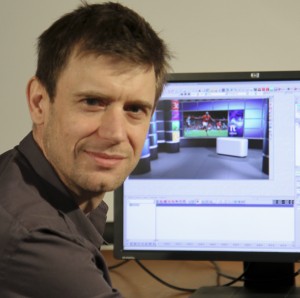Guest Comment: The reality of the virtual game
Sports broadcasters are always one step ahead of the game with the latest technological trends and this is certainly the case when it comes to augmented reality, writes Luke Harrison, technical product marketing manager, RT Software. We’ve all been a little bit in awe of the football coverage on BT Sport’s 4K channel and this has proven to be the perfect platform to show off the latest dynamic augmented reality techniques in all of their glory.
Whether it is clever immersive graphics and visualised data, or the brand new AR studios we have seen on BT Sport – the clear winners are the viewers, who are being treated to more immersive and enhanced viewing experiences. The great news is that technological advancements in the AR arena are constantly evolving, and this is could be just the start for broadcasters.
Every broadcaster wants to differentiate their coverage and stay ahead of the competition, and augmented reality graphics and 4K are some of the most advanced ways for them to achieve their goals. It makes sense that 4K is one of the drivers behind more advanced augmented reality techniques, as the huge jump in resolution allows the viewer to see vast amounts of detail and opens up more opportunities for broadcasters, particularly in areas such as advertising. From blades of grass on pitches to individual faces in the crowd, the level of detail lends itself to using real-time graphics solutions.
4K graphics and AR potential
One of the biggest trends for this year is 4K/UHD real-time graphics solutions, which broadcasters use to produce more advanced overlay and sports analysis. We are all aware that sports graphics solutions have played a key role on sporting shows for several years – from on-pitch telestration graphics such as lines, arrows and regions for in depth analysis, to the virtual advertising and jumbotrons used during live games.
Using the same technology that applies in virtual reality, augmented reality is a live view of a physical, real-world environment that has been ‘augmented’ with additional computer-generated elements such as sound, video and graphics. If we stay with the BT sport example, the AR technology is provided by RT Software, with immersive graphics, visualised data and statistics presented in a way that will help the presenters to tell stories in an engaging manner.
Since the BT shows kicked off last Autumn, RT Software’s tOG-VR3D solution has been in action with graphics ranging from an intricate night-time 3D map of Europe showing models of the stadiums at each host city, through to team formations using glass fronted slates rising up from the larger slates comparing two opposing players with action shots. The graphics achieved a level of realism and quality using advanced AR techniques such as Physical Based Rendering (PBR) to give the real-time and real-life effects for viewers. The audience are given the impression that the graphics are actually there, as they appear as 3D objects within the studio space and retain their perspective and position even as the studio cameras move.
Broadcasters do need to proceed with an air of caution and acquire some degree of external expertise. It is not as simple as bunging in a mass of AR graphics, regardless of how aesthetically-pleasing they may be. If the graphics are overused and with little context, they can appear gimmicky to the audience, and actually decrease the viewer experience. Done well, a graphic that really helps to tell a story will have a genuine impact and really engage the viewers.
Augmented reality has come a long way in recent years, and as the technology becomes more cutting-edge and accessible the trend is expected to grow across a range of applications. For viewers who are already used to seeing the most compelling and dynamic coverage of their chosen sport, 4K pictures and AR graphics may be the only way to satisfy their increasingly high levels of expectation – and for broadcasters, it may be the best way to stay one step ahead of the competition.

